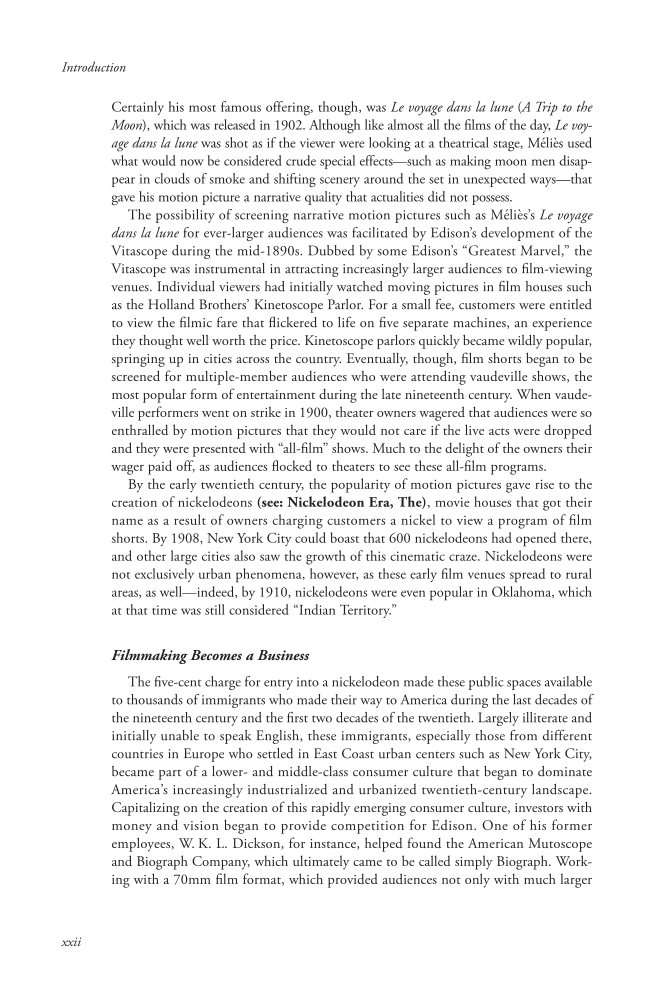Certainly his most famous offering, though, was Le voyage dans la lune (A Trip to the Moon), which was released in 1902. Although like almost all the films of the day, Le voy- age dans la lune was shot as if the viewer were looking at a theatrical stage, Melies ´ ` used what would now be considered crude special effects—such as making moon men disap- pear in clouds of smoke and shifting scenery around the set in unexpected ways—that gave his motion picture a narrative quality that actualities did not possess. The possibility of screening narrative motion pictures such as Melies’s ´ ` Le voyage dans la lune for ever-larger audiences was facilitated by Edison’s development of the Vitascope during the mid-1890s. Dubbed by some Edison’s “Greatest Marvel,” the Vitascope was instrumental in attracting increasingly larger audiences to film-viewing venues. Individual viewers had initially watched moving pictures in film houses such as the Holland Brothers’ Kinetoscope Parlor. For a small fee, customers were entitled to view the filmic fare that flickered to life on five separate machines, an experience they thought well worth the price. Kinetoscope parlors quickly became wildly popular, springing up in cities across the country. Eventually, though, film shorts began to be screened for multiple-member audiences who were attending vaudeville shows, the most popular form of entertainment during the late nineteenth century. When vaude- ville performers went on strike in 1900, theater owners wagered that audiences were so enthralled by motion pictures that they would not care if the live acts were dropped and they were presented with “all-film” shows. Much to the delight of the owners their wager paid off, as audiences flocked to theaters to see these all-film programs. By the early twentieth century, the popularity of motion pictures gave rise to the creation of nickelodeons (see: Nickelodeon Era, The), movie houses that got their name as a result of owners charging customers a nickel to view a program of film shorts. By 1908, New York City could boast that 600 nickelodeons had opened there, and other large cities also saw the growth of this cinematic craze. Nickelodeons were not exclusively urban phenomena, however, as these early film venues spread to rural areas, as well—indeed, by 1910, nickelodeons were even popular in Oklahoma, which at that time was still considered “Indian Territory.” Filmmaking Becomes a Business The five-cent charge for entry into a nickelodeon made these public spaces available to thousands of immigrants who made their way to America during the last decades of the nineteenth century and the first two decades of the twentieth. Largely illiterate and initially unable to speak English, these immigrants, especially those from different countries in Europe who settled in East Coast urban centers such as New York City, became part of a lower- and middle-class consumer culture that began to dominate America’s increasingly industrialized and urbanized twentieth-century landscape. Capitalizing on the creation of this rapidly emerging consumer culture, investors with money and vision began to provide competition for Edison. One of his former employees, W. K. L. Dickson, for instance, helped found the American Mutoscope and Biograph Company, which ultimately came to be called simply Biograph. Work- ing with a 70mm film format, which provided audiences not only with much larger Introduction xxii
Document Details My Account Print multiple pages
Print
You have printed 0 times in the last 24 hours.
Your print count will reset on at .
You may print 0 more time(s) before then.
You may print a maximum of 0 pages at a time.

































































































































































































































































































































































































































































































































































































































































































































































































































































































































































































































































































































































































































































































































































































































































































































































